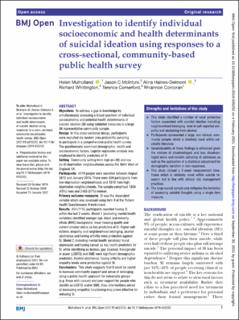| dc.contributor.author | Mulholland, Helen | |
| dc.contributor.author | McIntyre, Jason C. | |
| dc.contributor.author | Haines, Alina | |
| dc.contributor.author | Whittington, Richard | |
| dc.contributor.author | Comerford, Terence | |
| dc.contributor.author | Corcoran, Rhiannon | |
| dc.date.accessioned | 2021-10-05T07:48:14Z | |
| dc.date.available | 2021-10-05T07:48:14Z | |
| dc.date.created | 2021-09-30T16:54:16Z | |
| dc.date.issued | 2021 | |
| dc.identifier.citation | BMJ Open. 2021, 11 (2), 1-9. | en_US |
| dc.identifier.issn | 2044-6055 | |
| dc.identifier.uri | https://hdl.handle.net/11250/2787599 | |
| dc.description.abstract | Abstract Objectives To address a gap in knowledge by simultaneously assessing a broad spectrum of individual socioeconomic and potential health determinants of suicidal ideation (SI) using validated measures in a large UK representative community sample. Design In this cross-sectional design, participants were recruited via random area probability sampling to participate in a comprehensive public health survey. The questionnaire examined demographic, health and socioeconomic factors. Logistic regression analysis was employed to identify predictors of SI. Setting Community setting from high (n=20) and low (n=8) deprivation neighbourhoods across the North West of England, UK. Participants 4319 people were recruited between August 2015 and January 2016. There were 809 participants from low-deprivation neighbourhoods and 3510 from high-deprivation neighbourhoods. The sample comprised 1854 (43%) men and 2465 (57%) women. Primary outcome measures SI was the dependent variable which was assessed using item 9 of the Patient Health Questionnaire-9 instrument. Results 454 (11%) participants reported having SI within the last 2 weeks. Model 1 (excluding mental health variables) identified younger age, black and minority ethnic (BME) background, lower housing quality and current smoker status as key predictors of SI. Higher self-esteem, empathy and neighbourhood belonging, alcohol abstinence and having arthritis were protective against SI. Model 2 (including mental health variables) found depression and having cancer as key health predictors for SI, while identifying as lesbian, gay, bisexual, transgender or queer (LGBTQ) and BME were significant demographic predictors. Alcohol abstinence, having arthritis and higher empathy levels were protective against SI. Conclusions This study suggests that it could be useful to increase community support and sense of belonging using a public health approach for vulnerable groups (e.g. those with cancer) and peer support for people who identify as LGBTQ and/or BME. Also, interventions aimed at increasing empathic functioning may prove effective for reducing SI. | en_US |
| dc.language.iso | eng | en_US |
| dc.publisher | BMJ Publishing Group Ltd. | en_US |
| dc.rights | Navngivelse 4.0 Internasjonal | * |
| dc.rights.uri | http://creativecommons.org/licenses/by/4.0/deed.no | * |
| dc.title | Investigation to identify individual socioeconomic and health determinants of suicidal ideation using responses to a cross-sectional, community-based public health survey | en_US |
| dc.type | Peer reviewed | en_US |
| dc.type | Journal article | en_US |
| dc.description.version | publishedVersion | en_US |
| dc.source.pagenumber | 1-9 | en_US |
| dc.source.volume | 11 | en_US |
| dc.source.journal | BMJ Open | en_US |
| dc.source.issue | 2 | en_US |
| dc.identifier.doi | 10.1136/bmjopen-2019-035252 | |
| dc.identifier.cristin | 1941613 | |
| cristin.ispublished | true | |
| cristin.fulltext | original | |
| cristin.qualitycode | 1 | |

